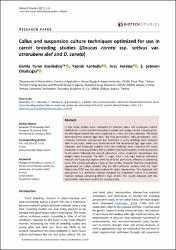| dc.contributor.author | Turan Büyükdinç, Damla | |
| dc.contributor.author | Kantaoğlu, Yaprak | |
| dc.contributor.author | Karataş, Arzu | |
| dc.contributor.author | Ellialtıoğlu, Şebnem | |
| dc.date.accessioned | 2023-10-06T07:07:17Z | |
| dc.date.available | 2023-10-06T07:07:17Z | |
| dc.date.issued | 2023 | en_US |
| dc.identifier.citation | Turan Büyükdinç, D., Kantaoğlu, Y., Karataş, A. & Ellialtıoğlu, Ş. (2023). Callus and suspension culture techniques optimized for use in carrot breeding studies (Daucus carota ssp. sativus var. atrorubens alef and D. carota). Biotech Studies, 32(1), 1-9. https://doi.org/10.38042/biotechstudies.1249244 | en_US |
| dc.identifier.issn | 2687-3761 | |
| dc.identifier.issn | 2757-5233 | |
| dc.identifier.uri | https://doi.org/10.38042/biotechstudies.1249244 | |
| dc.identifier.uri | https://hdl.handle.net/11436/8441 | |
| dc.description.abstract | In this study, studies were conducted to optimize callus and suspension culture
methods for in vitro mutation breeding in purple and orange carrots. Following this,
the developed mutant lines were subjected to in vitro salt stress selection. The study
determined the optimal agar dose. The first germination, 50% germination, rootcotyledon formation and genuine leaf formation in carrot seedlings were analyzed
daily in the study, which was continued with the determined 7g/L agar dose. The
cotyledon and hypocotyl explants from the seedlings were cultivated for callus
production in mixtures of MS-1, MS-2 and MS-3 nutritional medium. In the second and
fourth weeks following the second subculture, callus production percentages and
weights were measured. The MS-3 (1 mg/L 2,4-D + 0.5 mg/L kinetin) nutritional
medium and hypocotyl explant were found to be particularly effective at producing
callus. The second subculture's data on the number of plants that had successfully
regenerated per callus, showed that the MS nutritional medium with 0.2 mg/L
Thidiazuron (TDZ) was the best medium for plant regeneration. The dispersed calli
were grown in a nutritional medium designed for suspension culture in a nutrient
medium mixture comprising MS+0.1 mg/L kinetin. The results obtained with the
optimization steps were used in the ongoing study. | en_US |
| dc.language.iso | eng | en_US |
| dc.publisher | Tarla Bitkileri Merkez Araştırma Enstitüsü | en_US |
| dc.rights | info:eu-repo/semantics/openAccess | en_US |
| dc.subject | Orange carrot (Daucus carota L.) | en_US |
| dc.subject | Purple carrot (Daucus carota ssp. sativus var. atrorubens Alef ) | en_US |
| dc.subject | In vitro | en_US |
| dc.subject | Callus culture | en_US |
| dc.subject | Suspension culture | en_US |
| dc.title | Callus and suspension culture techniques optimized for use in carrot breeding studies (Daucus carota ssp. sativus var. atrorubens alef and D. carota) | en_US |
| dc.type | article | en_US |
| dc.contributor.department | RTEÜ, Ziraat Fakültesi, Bahçe Bitkileri Bölümü | en_US |
| dc.contributor.institutionauthor | Turan Büyükdinç, Damla | |
| dc.contributor.institutionauthor | Karataş, Arzu | |
| dc.identifier.doi | 10.38042/biotechstudies.1249244 | en_US |
| dc.identifier.volume | 32 | en_US |
| dc.identifier.issue | 1 | en_US |
| dc.identifier.startpage | 1 | en_US |
| dc.identifier.endpage | 9 | en_US |
| dc.relation.journal | Biotech Studies | en_US |
| dc.relation.publicationcategory | Makale - Ulusal Hakemli Dergi - Kurum Öğretim Elemanı | en_US |


















